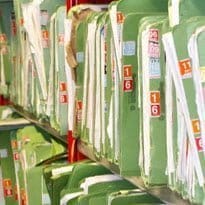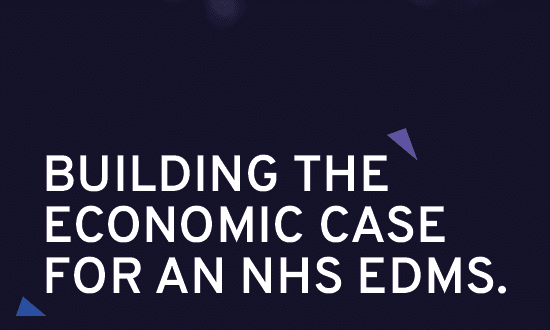A very Thurrock job
- 23 October 2012

In a meeting room at Basildon University Hospital, a moment of tension is triggered when the phrase “electronic document management” is used.
What the trust has developed, eHealth Insider is told, is much more than a document management system.
It is a system designed by clinicians for clinicians to make patient information available whenever and wherever they need it.
Lead clinician for the EMR project Ian Linehan explains: “My clinicians’ perspective of EDM is that it’s just a way for the trust to store records; it’s not what is used for managing records.”
In contrast, the EMR system gives clinicians 24/7 access to a patient’s medical record while letting them view test results, appointment times and other real-time information.
Linehan says the system is so well regarded that clinicians are actually asking to go live with it. “It’s the first time I have ever heard some of my colleagues volunteer to use computers,” he adds.
A different way of doing things
Paul Williams, EMR deployment lead, explains that in contrast to most EDM projects, Basildon realised it needed to put clinicians at the centre and push the relevant information to them.
The business case grew out of work started at other trusts and interviews with more than 1,000 clinicians across eight hospitals.
The original EMR tender was won by a supplier consortium and the system is now owned by Fortrus, which provides ongoing support.
As well as access to the historic records, the system displays information from the patient administration system, pathology, radiology, clinic letters, discharge summaries and others.
For one event, the system will pull data from the patient administration system – such as when the patient attended and who was in charge of their care – and marry that up with documentation associated with that event.
Williams says the system is constantly evolving to meet the needs of clinicians, rather than “burying them under hundreds of useless documents that have no relevance.”
Linehan demonstrates how case notes for complex patients can run to multiple volumes that would pass his waist if stacked on the floor.
Clinicians have ways of sifting through these physical piles of notes looking for certain words or dates to try and find what they need.
The EMR aims to replicate this process electronically and present the clinician with the information they need to know about the patient when they open the record.
Clinicians can set their own preferences for information they want presented on their home page and can search via events on a patient timeline or via the type of documentation they are looking for.
Building expertise
Basildon has built its own scanning operation and has trained its staff to index documents to tease out the relevant information. The team, which includes forward scanning, archive scanning and scanning on demand, has 45 staff.
Historical notes are not indexed unless the hospital knows the patient will be attending again soon. Around 200,000 case notes out of 450,000 have now been scanned, and 155 consultants out of 177 have been trained on the system.
The project started in October 2011 by scanning the medical records of patients coming into hospital to attend a paediatric clinic. It has now been expanded to the entire women’s and children department and a new clinic goes live every couple of days. Six specialities now have live clinics.
Those patients with e-records have spread out across the hospital and attended other departments so that now every specialty in the hospital has seen an EMR patient.
When a clinician starts their day they can log into the EMR system to see their clinic list and whether the patient has an electronic record. Even patients without historic records available will have other information, pulled from systems such as the PAS and pathology, available to view.
“We wanted to make sure that we drove so much value into this thing so even if the clinician is not in a live area there would be so much value on the system without the scanned notes that they would be driven to use it,” says Williams.
Security is another area that the trust has worked hard on. When a patient record is opened the user can see everyone else who has looked at that record and at any particular document.
The team is putting a series of flags in place to check on suspect activity such as a child’s record being looked at by someone who does not work in paediatrics or a record being viewed by someone with the same surname. There are also different levels of access to the patient record depending on a person’s role at the trust.
Impacts and benefits
Concern about the impact of the new technology on clinic appointment times led to the trust collaborating with Portsmouth University on an academic project.
Researchers benchmarked the clinicians’ normal routine with 300 patients, then looked again at 300 patient appointments using the EMR. Results will be published in the academic press, but the overall finding is that the system has no negative impact on clinic times.
Mark Magrath, director of strategy and development executive lead for the EMR project explains that the obvious benefits to patient care along with strong financial incentives meant the business case for an EMR was a “no-brainer” for the trust board.
Prior to this project, all medical records were kept in a warehouse costing the trust about £1m a year. One of the options available was to get another warehouse, but the trust decided this would add cost and no value and records would still not be available immediately to clinicians who need them.
In contrast, the electronic medical records solution would reduce cost “quite significantly” and improve patient care by having notes available in multiple places at the same time, explains Magrath.
Over ten years the implementation costs are £6.9m and running costs will be £7.5m. Over the same period, the cash-releasing savings are projected to be £17.7m.
Williams says the estimated savings are “on the light side” of what the trust will likely achieve as the business case was based on “very conservative” figures.
“The board viewed this almost as a no brainer, it was an overwhelming business case,” he says.




